MALI
Economy

Economy
Economy
General
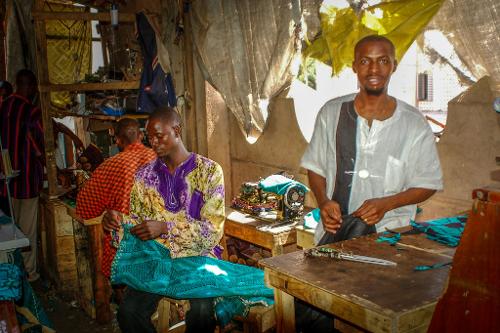 Bamako tailors, MaliPhoto: Ralf Stenberger CC 2.0 no changes moade
Bamako tailors, MaliPhoto: Ralf Stenberger CC 2.0 no changes moade
Mali is one of the poorest countries in the world. Per capita there is a GNP of no more than $ 2,200 per year (2017). Disappointing harvests and increases in oil prices have hit Mali's fragile economy very hard. The country had also not built up any reserves to absorb these blows.
The eighties were aimed at meeting their own food needs after a number of famines. This yielded little, but efforts are still being made to achieve this. They were even forced to import rice from Thailand.
Much of industrial production takes place in state-owned companies, but these companies suffer from losses, corruption and inefficiency. The government is trying to bring about economic reforms by privatizing state-owned companies, limiting public debt and cutting subsidies. They also try to tackle corruption. This is partly due to pressure from the International Monetary Fund and other foreign lenders. All these measures have transformed Mali's economy from a state-run to a mixed economy, although the government is still vigorously trying to steer the economy.
The Malians abroad (approx. 3 million) are of inestimable value to the economy. Because there is sometimes hardly any question of their own economy, whole areas of Mali are in fact dependent on remittances by family members abroad.
Agriculture, fishing, livestock and forestry
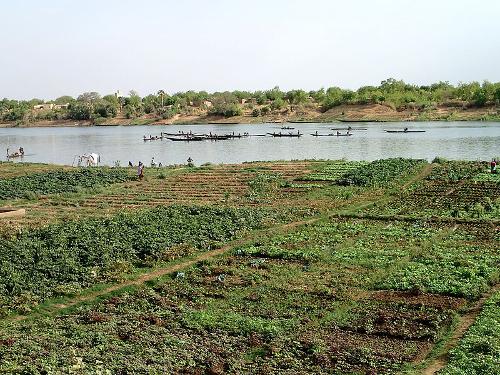 Vegetable gardens MaliPhoto: Freepius in the public domain
Vegetable gardens MaliPhoto: Freepius in the public domain
The basis of the Malian economy is still formed by agriculture, in which approx. 80% of the working population is active (2017). Most arable land is used to provide for its own food needs and it is mainly maize, rice, millet and sorghum that are grown for this. Millet and sorghum are important crops because they are resistant to drought. Important fruits are shea nuts and mangoes.
Cotton, sugar cane and groundnuts are grown for export. Cotton is currently the most important export product. The low wages in this labor-intensive branch of agriculture ensures low prices, which in turn are interesting for the exporting countries. Mali is currently the second largest cotton exporter in Africa after Egypt. Cotton, sugar cane and groundnuts are also processed in the local industries. The price for the purchase of agricultural products is set by the government. These prices are often much lower than in neighboring countries, resulting in quite a few smuggling practices.
Livestock farming is very important to the Malian economy, but it often suffers greatly from periods of persistent drought that regularly hit the country. It regularly happens that more than fifty percent of the cattle and sheep die. Live cattle exports are mainly focused on Ivory Coast, Liberia and Senegal.
Fishing on Mali's inland waters is also affected by the dry periods. Compared to a few years ago, the water level has declined structurally, leading to reduced catches.
Yet Mali is still the third largest fish producer in North and West Africa after Morocco and Senegal. The main fishing areas are the inland delta of the Niger and the lake area. Much of the catch is marketed in the form of smoked and dried fish on the domestic and foreign market. There are about 100,000 fishermen in Mali, concentrated around the Niger and Bani rivers. Most of the fishermen belong to the Bozo people.
The forests mainly provide firewood and timber for the traditional economy. Prolonged drought and irresponsible clearing of forests have resulted in a drastic decline in forestry resources and extensive soil erosion.
Mining and industry
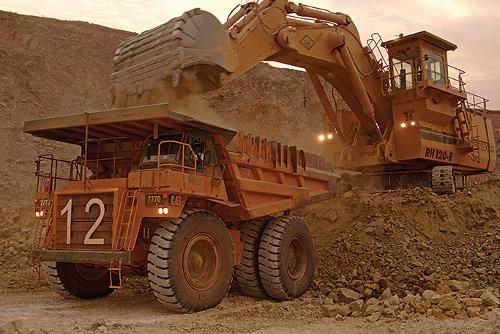 Work on gold mine in MaliPhoto: Iamgold CC 3.0 Unported no changes made
Work on gold mine in MaliPhoto: Iamgold CC 3.0 Unported no changes made
Mining is of little economic significance. A lack of technical knowledge and a good infrastructure means that the available mineral resources (especially iron ore) can hardly be exploited profitably. That is a shame because it has already been proven that Mali has reserves of uranium, bauxite, magnesium, lithium and copper. Salt is extracted in the north of the country and phosphate, lime and gold are also extracted on a small scale. Gold could become a major export commodity as a few international mining companies become involved in the exploitation.
The agro-industry is the most important for Mali, with the textile industry (cotton) in second place. These industries mainly focus on the processing of domestic raw materials. Poor harvests therefore have a direct negative impact on these industrial activities.
Energy supply
Energy is extracted from thermal power plants, but mainly from hydroelectric power plants. The production and distribution of the electricity is in the hands of the company Énergie du Mali. Energy is also still extracted from firewood. Due to extensive deforestation, other forms of energy supply are becoming increasingly important.
For example, the number of hydropower plants has not long ago expanded at the Selingué dam and one in the Bafing, a tributary of the Senegal. The intention of these investments is to ultimately provide for its own energy needs, but for the time being this is limited to the capital Bamako and Ségou. In addition to traditional forms of energy production, there is a desire to exploit solar energy economically. However, this modern way of energy production is not yet getting off the ground due to the high price of the imported solar panels.
Trade and development cooperation
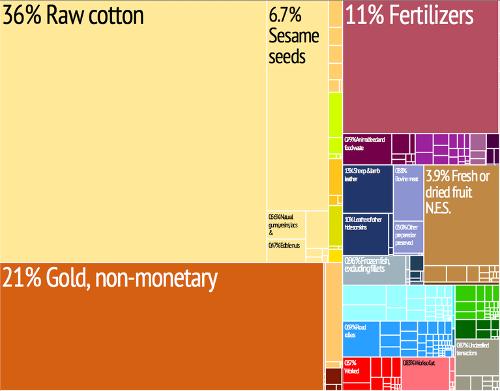 Export MaliPhoto: R Haussmann, Cesar Hidalgo, et. al CC 3.0 no changes made
Export MaliPhoto: R Haussmann, Cesar Hidalgo, et. al CC 3.0 no changes made
The trade deficit has always been very large, but has become somewhat more favorable in recent years.
The main exports of Mali are cotton, groundnuts, livestock and fish. In the year 2017, $ 3 billion dollars were exported mainly to Switzerland and the Gulf countries. Imported are machines and equipment, petroleum products, foodstuffs and stimulants. In the year 2017, $ 3.6 billion was imported from Ivory Coast, France, Senegal and China in particular.
Traffic
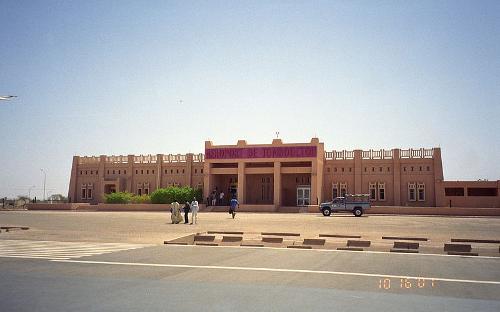 Timbuktu Airport in MaliPhoto: Upyernoz CC 2.0 Generic no changes made
Timbuktu Airport in MaliPhoto: Upyernoz CC 2.0 Generic no changes made
Three-quarters of passenger and goods traffic is done by road. The road network is 20,000 kilometers long, of which only just over 2500 kilometers is asphalted. The main road is that from the capital Bamako via Ségou and Mopte to Gao in Eastern Mali. Road connections with neighboring countries are generally very poor, sometimes no more than caravan tracks.
Since 1994, the main railway line has been that from Dakar in Senegal to Bamako. After Bamako, the railway continues for several tens of kilometers to the port city of Koulikoro. The north of Mali is hardly accessible.
The rivers Senegal and Niger are easily navigable at high tide, and the Niger in particular is Mali's main arterial road. It is then possible for the big Niger steamers to sail from Koulikoro to Gao. All important cities are therefore located on the Niger. In total, with favorable weather conditions and sufficient rainfall, approximately 1815 kilometers is navigable. The main port is Koulikoro.
There are international airports in Bamako-Segou and Mopti. The state-owned company Air Mali was disbanded in 1988 and Mali became a member of the Air Afrique group in 1992.
Sources
Te gast in Mali
Verre Reizen
Velton, R. / Mali
Bradt
Vlugt, B. / Mali
Gottmer
Westen, G. van / Mali : mensen, politiek, economie, cultuur
Koninklijk Instituut voor de Tropen
CIA - World Factbook
BBC - Country Profiles
Copyright: Team The World of Info